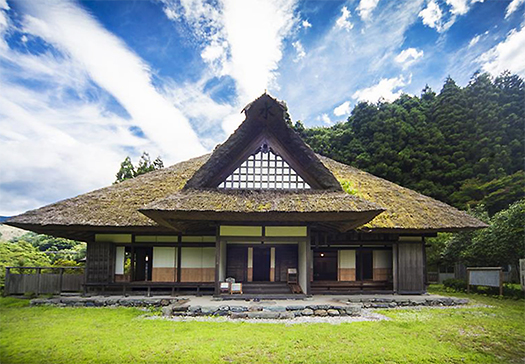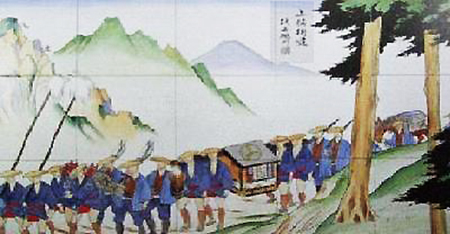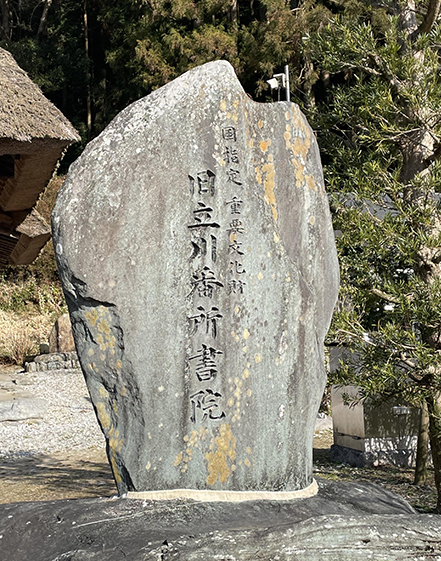


四国山地という天然の障害によって土佐は京大阪、江戸といった中心地域からは遠く隔てられた遠国。それをなんとか克服すべく山間を突破する道路開削が古代以来、努力が傾けられていた。そういう努力をあざ笑うかのように、江戸幕府は「参勤交代」という政治制度を強いていた。
参勤交代制度が諸藩の側からは重度の経済負担になり、幕府の側にして見ると諸藩の経済力を削ぐことで国内の政治軍事安定に効果があったことになる。江戸の平和はこのことが最大の要素だったとも思える。よくこういう平和戦略を考えついたと一面で感心する。
いったい参勤交代にはどれくらいの費用が必要だったのか?加賀100万石・前田家に「文化五年御帰国の御入用銀」という支出記録がある。江戸からの帰路の総費用は約5500両。1両=10万円とすると帰国の総経費が5億5000万円、そのうち人件費7410万円とされている。旅籠代(宿代)、川越賃(川渡りの料金)、他藩の領内を通過する際の贈答品、補償金など多岐にわたった。
加賀藩は土佐藩と比べれば距離は半分以下だろうけれど、収入は加賀100万石に対して土佐は20万石、5倍。石高に見合った「行列」を整えなければならなかったから、総費用は単純計算はできない。が、おおむね推測はできる。土佐藩は江戸初期、船を使っていたが日数が確定しにくかったのでこの立川を通る山間路を使うようになったとされている。たぶん、経済的に安上がりだった理由の方が大きかったに違いない。
この立川番所は土佐領の最北限。勘定方、経済担当にして見れば行きでは「ここから先は他藩領。金もどんどん掛かっていくぞ」と怖じ気づくようだっただろう。また帰路には「ようやく支出が抑えられる」とひと安心できたかのかどうか。自領内でも「権威を見せつける」という政治目的もあるから、それなりに見てくれだけは気遣うのだろう。つくづくムダな権威主義と思うが、そういう世が続いていた。
武士というのは「みてくれ」に異常に敏感な支配層だったのだろう。その習性を十分に骨の髄まで搾り取る制度が参勤交代だった。そしてこの制度は導入されてほぼ幕府滅亡直前まで継続した。こういう無駄遣いしているよりは実質的な国防予算に振り向けるべきだという正論はしかしなかなか実現しなかった。結局黒船ショックまで制度は変化しなかった。既得権益パワーなのか。日本というのはいったん決めたことを変えることが難しい社会なのかも知れない。
English version⬇
The Falsity of the Daimyo’s Visit to the Tosa Domain, Former Tachikawa Bansho Shoin-2
A “mite” system device that economically deprives the feudal lords of their military authority. While they were saying “down – down – down”, fierce economic hardship struck. …
The Shikoku Mountains are a natural obstacle that separates Tosa from the central regions of Kyoto, Osaka, and Edo (present-day Tokyo). In order to overcome this obstacle, efforts had been made since ancient times to open roads through the mountains. As if to mock such efforts, the Edo shogunate enforced a political system of “daimyo’s visit to and from the capital.
From the perspective of the shogunate, this system was a heavy economic burden on the clans, and from the perspective of the shogunate, it was effective for domestic political and military stability by reducing the economic power of the clans. This was the most important factor in the peace of Edo. I am impressed that the shogunate came up with such a peace strategy.
How much money did it cost to make the trip to Edo? The Maeda family of Kaga, one million koku, has a record of expenditures in the form of “Gokyoku no Goyo Ginyu (silver for the return trip in the 5th year of Bunka era). The total cost of the return trip from Edo was approximately 5,500 ryo, and assuming that 1 ryo = 100,000 yen, the total cost of the return trip was 550 million yen, of which personnel expenses were estimated at 7,410,000 yen. The cost of the journey included a wide range of items such as inns (lodging), fees for crossing the river, gifts and compensation for passing through the territory of other clans, etc. The Kaga Clan was the first clan in Japan to receive such compensation from the Tosa Clan.
The Kaga clan may have traveled less than half the distance of the Tosa clan, but its income was five times that of the Tosa clan, 200,000 koku compared to 1 million koku for the Kaga clan. The total cost cannot be simply calculated, since a “procession” had to be prepared to match the amount of stones. However, we can roughly estimate the total cost. It is said that the Tosa Clan used ships in the early Edo period, but because it was difficult to determine the number of days, they began to use a mountain route that passed through the Tachikawa River. Probably, the reason was that it was economically cheaper.
This Tachikawa guardhouse is the northernmost point of the Tosa territory. The accountant, the person in charge of the economy, was afraid to go there, saying, “From here on, it is another clan’s territory. The money was going to cost more and more. On the return trip, they may or may not have felt relieved that they could finally control their spending. I suppose that even within their own domain, they are only concerned about their appearance because they have the political objective of “showing off their authority. It seems to me that such authoritarianism was a waste of time and money, but such was the way of the world.
The samurai were probably a ruling class that was unusually sensitive to “appearances. The system that fully exploited this habit to its very marrow was the “sankyu-sho. This system was introduced and continued almost until just before the fall of the shogunate. The good argument that the budget should be allocated to actual defense rather than wasting money like this, however, did not come to fruition. In the end, the system did not change until the Black Ships Shock. Is it the power of vested interests? Perhaps Japan is a society in which it is difficult to change what has been decided once.
Posted on 4月 21st, 2023 by 三木 奎吾
Filed under: 日本社会・文化研究







コメントを投稿
「※誹謗中傷や、悪意のある書き込み、営利目的などのコメントを防ぐために、投稿された全てのコメントは一時的に保留されますのでご了承ください。」
You must be logged in to post a comment.